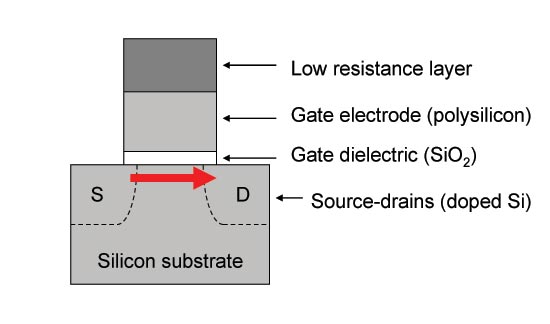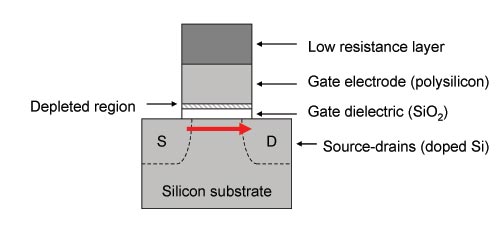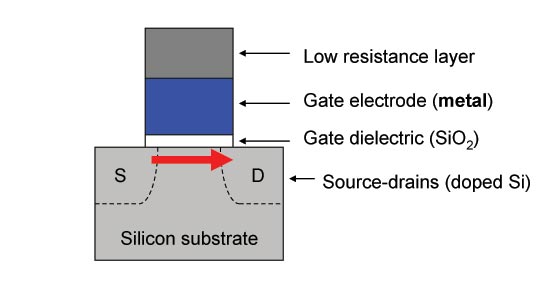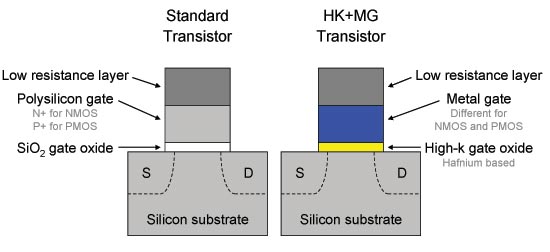Intel Demonstrates new 45nm Transistors and Conroe's Successor
by Anand Lal Shimpi on January 27, 2007 12:00 AM EST- Posted in
- CPUs
More Efficient Transistors
The basic function of a transistor as found in modern day microprocessors is to act as a switch with two states: on and off. When the transistor is on, current is allowed to flow from one terminal to the other (source to drain), and when it is off current shouldn't flow. Making enough current flow when it should and minimizing the amount that flows when it shouldn't is one of the major hurdles to making smaller transistors that run cooler/faster.
Below we have a typical CMOS transistor diagramed and labeled:

The voltage present at the Gate and the Source will determine whether or not current will flow in the transistor. Intel's 45nm process makes significant changes to two of the components in this transistor diagram: the gate electrode and the gate dielectric.
You can probably guess that as transistors get smaller, all of the parts of the transistor get smaller as well. The problem is that when some of these features get too small, they start behaving inappropriately. Case in point is the gate dielectric; with Intel's 90nm and 65nm processes, the gate dielectric was shrunk to a thickness of 1.2nm - the equivalent of about 5 atoms. The benefit of a very thin gate dielectric is that it increases the gate field effect, which increases drive current and reduces Source-drain leakage current. However, with such a thin gate dielectric electrons can tunnel directly through the layer and show up as leakage current - in other words, current would flow when it was not supposed to, translating into power wasted. On an individual transistor scale it's not such a big deal, but when you keep in mind that Penryn will have around 410 million of these transistors (820 million for quad-core) the leakage current/power draw does add up.
At 1.2nm, the gate oxide/gate dielectric in Intel's 90nm and 65nm transistors was as thin as Intel could make it without losing a great deal of power due to gate oxide leakage current. In order to make the move to 45nm Intel had to do something to thin the gate oxide without drastically increasing gate oxide leakage current.
Intel solved the gate oxide leakage problem by replacing the SiO2 gate dielectric with a material that has a higher k-value, in this case a Hafnium based material. A high-k dielectric here actually increases drive current at the same thickness as the previous SiO2 dielectric, while reducing gate leakage as well. Intel isn't disclosing how thick the Hafnium gate dielectric layer is in its 45nm transistors, but we do know that it is thicker than the 1.2nm SiO2 gate dielectric used in previous 90nm and 65nm transistors.

The second problem Intel is addressing with its 45nm transistors is a fundamental issue with the polysilicon gate electrode. The role of the gate electrode is important as it is what enables current to be driven through the transistor and as such it plays a role in how much current can be delivered. The polysilicon material that the gate electrode is made of has a tendency to form a region of depleted conducting carriers at the bottom of the gate, which reduces the drive strength of the transistor (less current flows when it needs to).

Intel's new 45nm transistors solve this problem by replacing the polysilicon gate electrode with a metal gate electrode, which completely eliminates the depleted region thus increasing the drive current.
Intel has been researching this High-k + Metal Gate (HK+MG) combination in transistors for a handful of years now, with hundreds of material options for metal gate electrodes and high-k dielectrics. The actual combination of high-k and metal gate material isn't being disclosed at this time, most likely to protect Intel's research and maintain the manufacturing advantage as long as possible. Intel expects that no other company will have HK+MG transistors until they reach 32nm or later.

The tangible advantages of these changes in materials in combination with the smaller 45nm process are quite large. According to Intel, the move from 65nm to 45nm yields a 30% reduction in transistor switching power because of the simple fact that smaller transistors have less parasitic capacitance and require less power to switch on and off.
Because of the combination of a high-k dielectric and the metal gate electrode, Intel is quoting a greater than 20% improvement in switching speed compared to its 65nm transistors. At the same speed as its 65nm transistors, there's a greater than 5x reduction in source-drain leakage power and a greater than 10x reduction in gate oxide leakage power; the latter is due entirely to the use of a high-k dielectric in the transistor. The end results of all of this are more power efficient processors, the first of which we should see by the end of this year.










59 Comments
View All Comments
Viditor - Tuesday, January 30, 2007 - link
It's amazing the number of people who have said that since Conroe was introduced...
In point of fact, Intel has dropped over the last year...
Frankly, neither Intel nor AMD will be making much headway while there's a price war on, though AMD will probably regain their losses in the second half of the year.
Intel shares should be close to what they are now in a year (unless of course AMD has a terrorist attack) because (as they guided) their Gross Margins aren't expected to rise at all over the next year.
blackbrrd - Tuesday, January 30, 2007 - link
Actually Intel released the Core 2 Duo around Jul. 2006. At the time a share was worth around 18$ The current value on an Intel share is roughly 21$ (Jan. 30th 2007). In other words an increase of about 16% since they released the Core 2 Duo.Viditor - Tuesday, January 30, 2007 - link
Most of that was seasonality...At the beginning of 2006, Intel was $25.05...so year-on-year (and in a year that Intel released and had 6 months of Conroe), Intel dropped ~20%...
The key point is that while technology is important, Gross Margins are far MORE important!
BladeVenom - Saturday, January 27, 2007 - link
I wouldn't be so bullish on Intel until you've seen AMD's next chip.bamacre - Saturday, January 27, 2007 - link
I'm not worried about it. Intel is serious about being the performance leader right now. They know they have made mistakes, and they know what they have to do to keep the crown. And they also have the tools to keep it. Whatever AMD comes out with, Intel will counter. Just watch.Slappi - Saturday, January 27, 2007 - link
Wow 125%? You must of mortgaged your house and bought Jan 2009 calls then with all your money.Market Cap of 250-300 billion dollars for a company with falling margins, losing market share and estimates of 1.20-1.30 for 2007. That would give them a PE of 32 for a company in the middle of a price war.
I don't think so.
I wouldn't short or buy INTEL at this point. No Way. Too unpredictable right now. 35 to 45 within a year? Even if AMD went bankrupt and closed its doors I doubt you would see 45 in 12 months.
I would however buy AMD and sell CCs on em around 17-18. R600 K8L should do them for around 18 in the next 6 months. You could make good money selling calls 10% out for a few months.
bamacre - Sunday, January 28, 2007 - link
"falling margins, losing market share "That is changing as I type.
hubajube - Monday, January 29, 2007 - link
No it's not. He's spot on.yyrkoon - Saturday, January 27, 2007 - link
Spoken like a true, disgruntled AMD fan boi. (or 'person' if you like). When will you guys learn, it doesn't matter WHO makes the 'best' CPU, and that close competition means win, win, for whoever, using whatever.JumpingJack - Sunday, January 28, 2007 - link
Yep, don't like one bit do they ---- hey, lets compare the OC of a 65 nm AMD chip to the OC of an Intel 65 nm chip ....
Intel has removed the major stumbling block for device scaling that has plagued both 90 and 65 nm.... it only get's better from here.